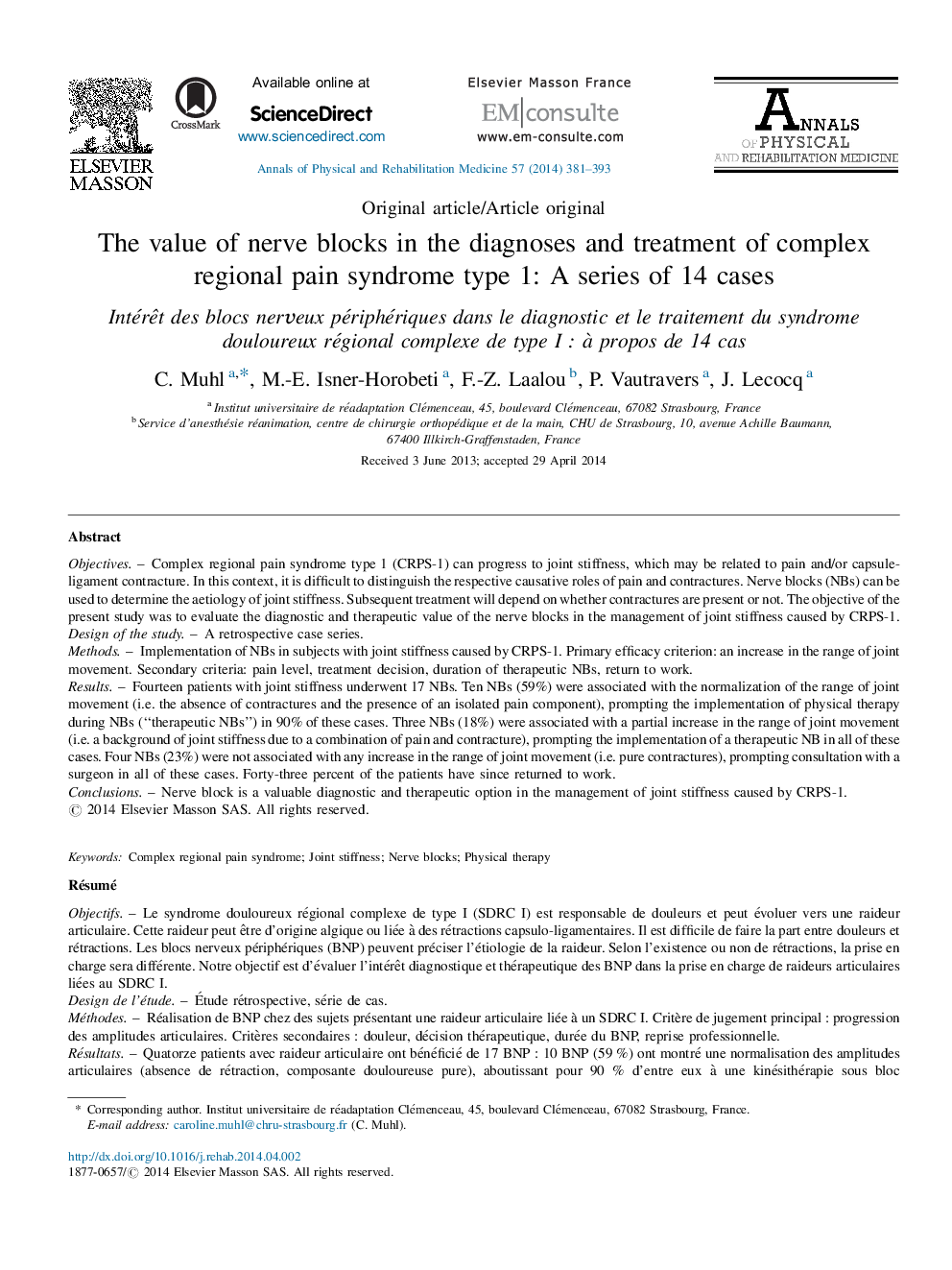| کد مقاله | کد نشریه | سال انتشار | مقاله انگلیسی | نسخه تمام متن |
|---|---|---|---|---|
| 4040531 | 1603306 | 2014 | 13 صفحه PDF | دانلود رایگان |
ObjectivesComplex regional pain syndrome type 1 (CRPS-1) can progress to joint stiffness, which may be related to pain and/or capsule-ligament contracture. In this context, it is difficult to distinguish the respective causative roles of pain and contractures. Nerve blocks (NBs) can be used to determine the aetiology of joint stiffness. Subsequent treatment will depend on whether contractures are present or not. The objective of the present study was to evaluate the diagnostic and therapeutic value of the nerve blocks in the management of joint stiffness caused by CRPS-1.Design of the studyA retrospective case series.MethodsImplementation of NBs in subjects with joint stiffness caused by CRPS-1. Primary efficacy criterion: an increase in the range of joint movement. Secondary criteria: pain level, treatment decision, duration of therapeutic NBs, return to work.ResultsFourteen patients with joint stiffness underwent 17 NBs. Ten NBs (59%) were associated with the normalization of the range of joint movement (i.e. the absence of contractures and the presence of an isolated pain component), prompting the implementation of physical therapy during NBs (“therapeutic NBs”) in 90% of these cases. Three NBs (18%) were associated with a partial increase in the range of joint movement (i.e. a background of joint stiffness due to a combination of pain and contracture), prompting the implementation of a therapeutic NB in all of these cases. Four NBs (23%) were not associated with any increase in the range of joint movement (i.e. pure contractures), prompting consultation with a surgeon in all of these cases. Forty-three percent of the patients have since returned to work.ConclusionsNerve block is a valuable diagnostic and therapeutic option in the management of joint stiffness caused by CRPS-1.
RésuméObjectifsLe syndrome douloureux régional complexe de type I (SDRC I) est responsable de douleurs et peut évoluer vers une raideur articulaire. Cette raideur peut être d’origine algique ou liée à des rétractions capsulo-ligamentaires. Il est difficile de faire la part entre douleurs et rétractions. Les blocs nerveux périphériques (BNP) peuvent préciser l’étiologie de la raideur. Selon l’existence ou non de rétractions, la prise en charge sera différente. Notre objectif est d’évaluer l’intérêt diagnostique et thérapeutique des BNP dans la prise en charge de raideurs articulaires liées au SDRC I.Design de l’étudeÉtude rétrospective, série de cas.MéthodesRéalisation de BNP chez des sujets présentant une raideur articulaire liée à un SDRC I. Critère de jugement principal : progression des amplitudes articulaires. Critères secondaires : douleur, décision thérapeutique, durée du BNP, reprise professionnelle.RésultatsQuatorze patients avec raideur articulaire ont bénéficié de 17 BNP : 10 BNP (59 %) ont montré une normalisation des amplitudes articulaires (absence de rétraction, composante douloureuse pure), aboutissant pour 90 % d’entre eux à une kinésithérapie sous bloc (BNP thérapeutique). Trois BNP (18 %) ont montré une amélioration partielle des amplitudes articulaires (association douleur + rétractions), conduisant tous à un BNP thérapeutique. Quatre BNP (23 %) ont montré une absence d’amélioration des amplitudes articulaires (rétractions pures), aboutissant tous à un avis chirurgical. Quarante-trois pour cent des patients ont repris une activité professionnelle.ConclusionsLes BNP représentent une alternative diagnostique et thérapeutique dans la prise en charge de raideurs articulaires liées au SDRC I.
Journal: Annals of Physical and Rehabilitation Medicine - Volume 57, Issues 6–7, August–September 2014, Pages 381–393
